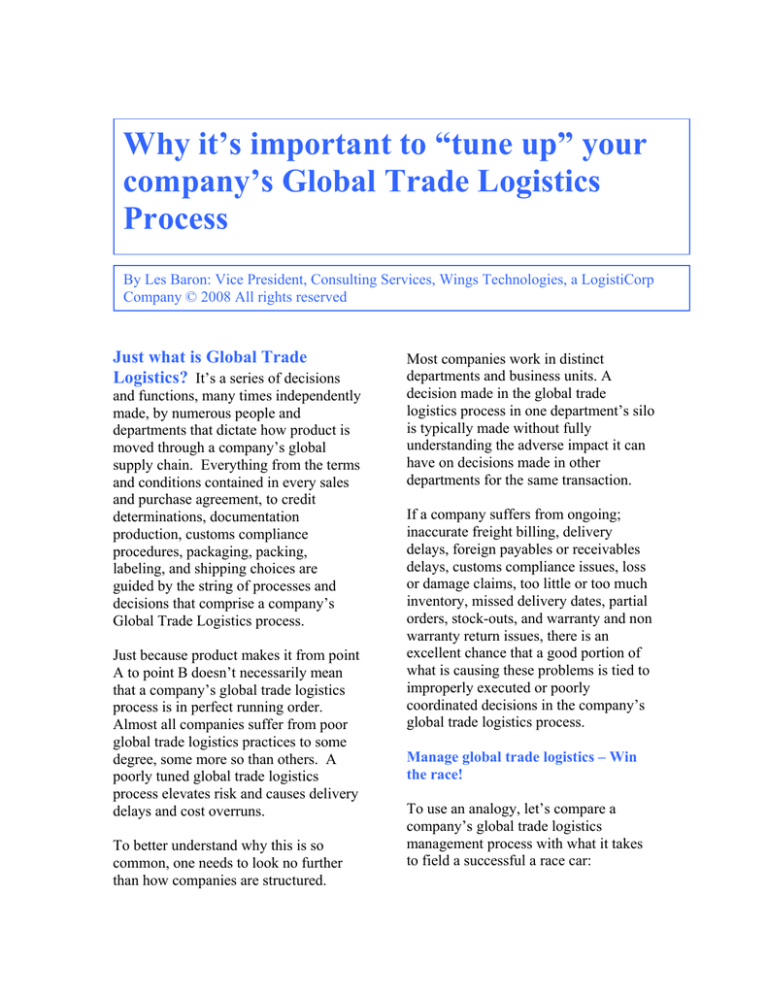
Why it’s important to “tune up” your
company’s Global Trade Logistics
Process
By Les Baron: Vice President, Consulting Services, Wings Technologies, a LogistiCorp
Company © 2008 All rights reserved
Just what is Global Trade
Logistics? It’s a series of decisions
and functions, many times independently
made, by numerous people and
departments that dictate how product is
moved through a company’s global
supply chain. Everything from the terms
and conditions contained in every sales
and purchase agreement, to credit
determinations, documentation
production, customs compliance
procedures, packaging, packing,
labeling, and shipping choices are
guided by the string of processes and
decisions that comprise a company’s
Global Trade Logistics process.
Just because product makes it from point
A to point B doesn’t necessarily mean
that a company’s global trade logistics
process is in perfect running order.
Almost all companies suffer from poor
global trade logistics practices to some
degree, some more so than others. A
poorly tuned global trade logistics
process elevates risk and causes delivery
delays and cost overruns.
To better understand why this is so
common, one needs to look no further
than how companies are structured.
Most companies work in distinct
departments and business units. A
decision made in the global trade
logistics process in one department’s silo
is typically made without fully
understanding the adverse impact it can
have on decisions made in other
departments for the same transaction.
If a company suffers from ongoing;
inaccurate freight billing, delivery
delays, foreign payables or receivables
delays, customs compliance issues, loss
or damage claims, too little or too much
inventory, missed delivery dates, partial
orders, stock-outs, and warranty and non
warranty return issues, there is an
excellent chance that a good portion of
what is causing these problems is tied to
improperly executed or poorly
coordinated decisions in the company’s
global trade logistics process.
Manage global trade logistics – Win
the race!
To use an analogy, let’s compare a
company’s global trade logistics
management process with what it takes
to field a successful a race car:
Just as a company’s ultimate objective is
to deliver product on time and on
budget, the objective of the race car is to
deliver a win by running the entire race
quickly and without breaking down so it
crosses the finish line ahead of the
competition. However, just having a
race car doesn’t mean the race is already
won!
To win, all of the car’s components and
every member of the pit crew must work
in perfect harmony to insure the car has
a chance of being competitive. This
means, not only does each nut, bolt, and
washer must be in perfect working order,
but each crew member must understand
how to do their job, and how their job
impacts the jobs of other crew members
so the tuning process or pit stop makes
sure the race car never falters.
Taking time in the beginning to make
sure all the car’s components are in
excellent working order and that the pit
crew’s individual jobs are understood
and in sync the rest of the crew will
allow the car to run with the rest of the
pack. And, if this overall process is
better than the competition, chances are
this car will be in the winner’s circle
more often than not.
Keeping this story in mind makes it very
clear why it is a wise company who
works at improving their global trade
logistics process before taking on any
global supply chain related
improvements. Since most supply chain
initiatives are aimed at increasing
velocity, companies will never gain the
full advantage of such initiatives if their
global trade logistics practices are not
improved beforehand.
At Wings Technologies, we understand
the impact on financial and functional
improvement a finely tuned global trade
logistics process can have on a
company’s bottom line. Our proprietary
assessment process allows us to look at a
company’s entire global trade logistics
process and string together all of the
disparate decisions and components that
are currently in use.
We pinpoint problem areas down to the
root cause many times, even to the desk
level. Once these issues are exposed, we
can impart the requisite knowledge using
our global trade logistics training
curriculum to plug these holes and
reduce or eliminate future problems.

